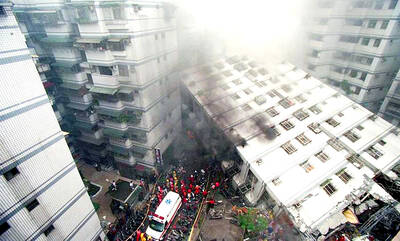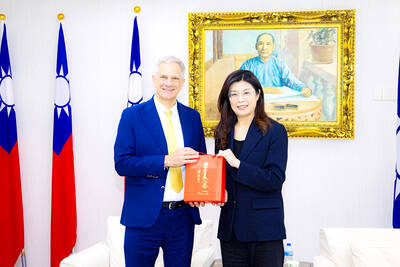Chinese contemporary artist Zhang Huan
(張洹) garnered an early reputation as somewhat of an enfant terrible of Beijing’s art world. In his breakout 12 Square Meters he examined the tortures of existence by smearing his naked body with fish oil and honey after which he sat for an hour in a
bug-infested latrine. The 1995 To Add One Meter to an Anonymous Mountain (為無名山增高一米) consisted of 10 naked bodies piled on the summit of Miaofengshan (妙峰山) west of Beijing, with nine artists later the same day simulating intercourse with a nearby peak.
Videos of these performance works are currently on view at the Museum of Contemporary Art, Taipei, and form part of a retrospective of Zhang’s oeuvre under the title Amitoufo (阿彌陀佛). The show provides a solid overview of the artist’s career, from his early existential investigations and social critiques to his later Buddhist-inspired sculptures and ash on linen paintings.
Trained as an oil painter at Beijing’s Central Academy of Fine Arts, Zhang became disenchanted by the limitations of the medium and began experimenting with performance art. At this time, Zhang and other like-minded Chinese artists established the Beijing East Village, which enabled
the burgeoning artist to explore his new direction.
But audiences and critics generally met his penchant to perform naked with bafflement or derision, so in 1998 Zhang moved to New York, an environment more amenable to his performance art.
Two videos at MOCA are representative of his New York period. The 1998 Pilgrimage — Wind and Water in New York (朝拜–紐約風水) shows a naked Zhang lying face down on a Ming-style bed that is covered with thick blocks of ice, while My America (Hard to Assimilate) (我的美國) features a naked Zhang sitting on a stool as 60 volunteers, also naked, pelt him with loaves of bread.
The videos suggest the isolation of recent immigrants to New York and subtly poke fun at the city’s (and America’s) multicultural presumptions.
Zhang returned to China and opened a studio in Shanghai in 2006. It was at this time that he became a practicing Buddhist — a spiritual transformation that has informed his work ever since.
Amitoufo’s curator, Yang Shin-Yi (楊心一), does a superb job of showing this remarkable change by juxtaposing Zhang’s revelatory performance videos with his religiously inspired sculptures.
Buddhist influences are manifest in the hanging leather sculpture Cowskin Buddha Face No. 4 (牛皮佛臉4號). The hide is shaped to form the face of Buddha and hints at the inseparable relationship between animal and human, flesh and spirit.
A more general examination of China’s religious heritage can be found in Chinese Civilian & Chinese Warrior (文化部長和國防部長). The 5m-tall sculptures of the gods of literature and war are embedded with Buddhist relics, offering dishes and unburned incense sticks, invoking the ritualistic aspects of religion and its appearance in Zhang’s artistic practice.
There is much else to see in Amitoufo: The 11 ash paintings that examine China’s history from the Republican period until 1970 offer an interesting statement about the country’s public memory and future. But the value of the exhibit lies in the curator’s ability to demonstrate how Zhang channeled the existential angst of his early performance art into the transcendent calmness of his later paintings and sculptures.

Seven hundred job applications. One interview. Marco Mascaro arrived in Taiwan last year with a PhD in engineering physics and years of experience at a European research center. He thought his Gold Card would guarantee him a foothold in Taiwan’s job market. “It’s marketed as if Taiwan really needs you,” the 33-year-old Italian says. “The reality is that companies here don’t really need us.” The Employment Gold Card was designed to fix Taiwan’s labor shortage by offering foreign professionals a combined resident visa and open work permit valid for three years. But for many, like Mascaro, the welcome mat ends at the door. A

Last week gave us the droll little comedy of People’s Republic of China’s (PRC) consul general in Osaka posting a threat on X in response to Japanese Prime Minister Sanae Takaichi saying to the Diet that a Chinese attack on Taiwan may be an “existential threat” to Japan. That would allow Japanese Self Defence Forces to respond militarily. The PRC representative then said that if a “filthy neck sticks itself in uninvited, we will cut it off without a moment’s hesitation. Are you prepared for that?” This was widely, and probably deliberately, construed as a threat to behead Takaichi, though it

If China attacks, will Taiwanese be willing to fight? Analysts of certain types obsess over questions like this, especially military analysts and those with an ax to grind as to whether Taiwan is worth defending, or should be cut loose to appease Beijing. Fellow columnist Michael Turton in “Notes from Central Taiwan: Willing to fight for the homeland” (Nov. 6, page 12) provides a superb analysis of this topic, how it is used and manipulated to political ends and what the underlying data shows. The problem is that most analysis is centered around polling data, which as Turton observes, “many of these

Since Cheng Li-wun (鄭麗文) was elected Chinese Nationalist Party (KMT) chair on Oct. 18, she has become a polarizing figure. Her supporters see her as a firebrand critic of the ruling Democratic Progressive Party (DPP), while others, including some in her own party, have charged that she is Chinese President Xi Jinping’s (習近平) preferred candidate and that her election was possibly supported by the Chinese Communist Party’s (CPP) unit for political warfare and international influence, the “united front.” Indeed, Xi quickly congratulated Cheng upon her election. The 55-year-old former lawmaker and ex-talk show host, who was sworn in on Nov.